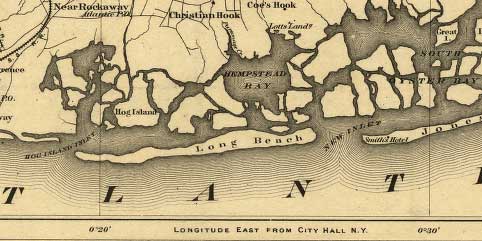Last-Minute NYC Holiday Gift Guide 🎁
We’ve created a holiday gift guide with presents for the intrepid New Yorker that should arrive just in time—


Image via Wikimedia Commons
You’ve definitely heard of disappearing ships. Plenty of them do, given the amount of shipwrecks historians and oceanographers have found around New York City alone. But disappearing islands? That’s a bit of a different story. In true Bermuda Triangle fashion, New York City has a disappearing island of its own, shrouded in multiple versions of the truth and curious to historians even today. It was called Hog Island, and the story goes that after New York was hit by the famous Hurricane of 1893, Hog Island disappeared without a trace, never to be found again.
That’s the story anyway. Multiple sources give slightly conflicting definitions of the full history of Hog Island. Some hold that Hog Island was actually the name of two different islands off the coast of Rockaway Beach near Long Island, while others say it was one island. Some insist that Hog Island is so named because the Native Americans used to breed swine on its grounds, away from the hustle and bustle of the fields and relatively safe from predators on an island while others say that settlers named the plucky little island after a hog because it resembled, once drawn on maps, the backside of one. Regardless, what might be the most interesting thing about the place is that if you look for it today, you won’t find it.
The stories my diverge on how exactly Hog Island disappeared, but only one thing is for sure: maps of early settled New York and Long Island include the land mass, designed Hog Island, and if you go there today, you’ll find nothing but water.
There are a few stories about Hog Island’s disappearance. The most popular one says that Hog Island was some sort of settlement off the coast of Rockaway Beach that was overrun by the churning waters of the storm of 1893, often called the Midnight Storm. Primary sources indicate residents near the beach fighting through waist-high water, 30-foot waves, and winds reaching speeds retroactively estimated to be around 115 miles per hour. As such a small landmass, this theory hypothesizes, based on first-hand accounts,that Hog Island was simply disintegrated overnight by the gale force winds and destructive tides.
The other story holds that Hog Island did not fully disappear, despite being damaged by the hurricane, for years afterwards, with reports showing that the island still functioned as a resort in 1902. The date of the island’s final sinking beneath the waves is estimated to be sometime around the 1920s.
Advancing science seems to support the latter theory, given that the 1893 Hurricane was classified decades later based on descriptions of its damage as a category-2 storm. While scientists mostly agree would not have been powerful enough to destroy an island of Hog Island’s size, a good deal of mystery still remains around the former island and the area. A particularly farfetched urban legend, surprisingly reported by The New York Times, surrounds the island’s creation, that it ‘rose up in a single night‘ in the late 1860s.
But perhaps we’re getting away from the point. Maps don’t lie, and most early maps of Long Island show a land mass where there is none today. It may seem like a while by today’s standards, but the fact that an island large enough to raise cattle and function as a popular resort destination for New Yorkers disappeared without a single trace behind it seems a pretty fascinating example of New York’s changing geography. Who knows. We may be seeing a few more disappearing islands in the years to come.
Next, read about 8 abandoned islands in New York City. Get in touch with the author @jinwoochong.
Subscribe to our newsletter